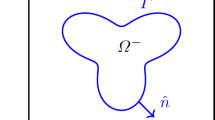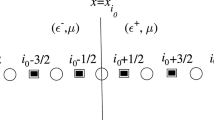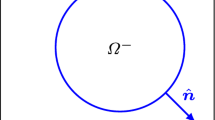Abstract
In this work, we propose staggered FDTD schemes based on the correction function method (CFM) to discretize Maxwell’s equations with embedded perfect electric conductor boundary conditions. The CFM uses a minimization procedure to compute a correction to a given FD scheme in the vicinity of the embedded boundary to retain its order. The minimization problem associated with CFM approaches is analyzed in the context of Maxwell’s equations with embedded boundaries. In order to obtain a well-posed minimization problem, we propose fictitious interfaces to fulfill the lack of information, namely the surface current and charge density, on the embedded boundary. We introduce CFM-FDTD schemes based on the well-known Yee scheme and a fourth-order staggered FDTD scheme. We investigate the stability of these CFM-FDTD schemes using long time simulations. Convergence studies are performed in 2-D for various geometries of the embedded boundary. CFM-FDTD schemes have shown high-order convergence.
















Similar content being viewed by others
Availability of data and materials
All data generated or analyzed during this study are included in this article.
Code availability
The custom code used for this work is not yet publicly available.
References
Abraham, D.S., Giannacopoulos, D.D.: A parallel implementation of the correction function method for Poisson’s equation with immersed surface charges. IEEE Trans. Magn. 53(6), 1–4 (2017)
Abraham, D.S., Marques, A.N., Nave, J.C.: A correction function method for the wave equation with interface jump conditions. J. Comput. Phys. 353, 281–299 (2018)
Assous, F., Ciarlet, P., Labrunie, S.: Mathematical Foundations of Computational Electromagnetism. Springer, Berlin (2018)
Chen, Z., Wang, L., Zheng, W.: An adaptive multilevel method for time-harmonic Maxwell equations with singularities. SIAM J. Sci. Comput. 29, 118–138 (2007)
Chen, Z., Xiao, Y., Zhang, L.: The adaptive immersed interface finite element method for elliptic and Maxwell interface problems. J. Comput. Phys. 228, 5000–5019 (2009)
Cockburn, B., Li, F., Shu, C.W.: Locally divergence-free discontinuous Galerkin methods for the Maxwell equations. J. Comput. Phys. 194(2), 588–610 (2004)
Cohen, G., Ferrieres, X., Pernet, S.: A spatial high-order hexahedral discontinuous Galerkin method to solve Maxwell’s equations in time domain. J. Comput. Phys. 217, 340–363 (2006)
Ditkowski, A., Dridi, K., Hesthaven, J.S.: Convergent Cartesian grid methods for Maxwell equations in complex geometries. J. Comput. Phys. 170, 39–80 (2001)
Fan, G.X., Liu, Q.H., Hesthaven, J.S.: Multidomain pseudospectral time-domain simulations of scattering by objects buried in lossy media. IEEE Trans. Geosci. Remote Sens. 40, 1366–1373 (2002)
Galagusz, R., Shirokoff, D., Nave, J.C.: A Fourier penalty method for solving the time-dependent Maxwell’s equations in domains with curved boundaries. J. Comput. Phys. 306, 167–198 (2016)
Ghrist, M., Fornberg, B., Driscoll, T.A.: Staggered time integrators for wave equations. SIAM J. Numer. Anal. 38, 718–741 (2000)
Gustafsson, B., Kreiss, H.O., Oliger, J.: Time-Dependent Problems and Difference Methods. Wiley, London (1995)
Hesthaven, J.S.: High-order accurate methods in time-domain computational electromagnetics: a review. Adv. Imag. Electron Phys. 127, 59–123 (2003)
Hesthaven, J.S., Warburton, T.: Nodal high-order methods on unstructured grids: I. Time-domain solution of Maxwell’s equations. J. Comput. Phys. 181, 186–221 (2002)
Hesthaven, J.S., Warburton, T.: Nodal Discontinuous Galerkin Methods?: Algorithms, Analysis, and Applications. Springer, New York (2008)
Inan, U.S., Inan, A.S., Said, R.K.: Engineering Electromagnetics and Waves. Pearson, London (2014)
Jurgens, T.G., Taflove, A., Umashankar, K., Moore, T.G.: Finite-difference time-domain modeling of curved surfaces. IEEE Trans. Antennas Propag. 40, 357 (1992)
Kallemov, B., Bhalla, A.P.S., Griffith, B.E., Donev, A.: An immersed boundary method for rigid bodies. Commun. Appl. Math. Comput. Sci. 11, 79–141 (2016)
Law, Y.M., Marques, A.N., Nave, J.C.: Treatment of complex interfaces for Maxwell’s equations with continuous coefficients using the correction function method. J. Sci. Comput. 82(3), 56 (2020)
Marques, A.N., Nave, J.C., Rosales, R.R.: A correction function method for Poisson problems with interface jump conditions. J. Comput. Phys. 230, 7567–7597 (2011)
Marques, A.N., Nave, J.C., Rosales, R.R.: High order solution of Poisson problems with piecewise constant coefficients and interface jumps. J. Comput. Phys. 335, 497–515 (2017)
Marques, A.N., Nave, J.C., Rosales, R.R.: Imposing jump conditions on nonconforming interfaces for the correction function method: a least squares approach. J. Comput. Phys. 397, 108869 (2019)
Stein, D.B., Guy, R.D., Thomases, B.: Immersed boundary smooth extension: a high-order method for solving PDE on arbitrary smooth domains using Fourier spectral methods. J. Comput. Phys. 304, 252–274 (2016)
Wang, J., Yin, W.: Development of a novel FDTD (2,4)-compatible conformal scheme for electromagnetic computations of complex curved PEC objects. IEEE Trans. Antennas Propag. 61, 299–309 (2013)
Wang, L., Hou, S., Shi, L., Zhang, P.: A numerical method for solving the variable coefficient wave equation with interface jump conditions. Int. J. Numer. Anal. Model. 16, 1–17 (2019)
Yang, B., Gottlieb, D., Hesthaven, J.S.: Spectral simulations of electromagnetic wave scattering. J. Comput. Phys. 134, 216–230 (1997)
Yee, K.S.: Numerical solution of initial boundary value problems involving Maxwell’s equations in isotropic media. IEEE Trans. Antennas Propag. 14(3), 302–307 (1966)
Yee, K.S., Chen, J.S., Chang, A.H.: Conformal finite difference time domain (FDTD) with overlapping grids. IEEE Trans. Antennas Propag. 40, 1068 (1992)
Yu, S., Zhou, Y., Wei, G.W.: Matched interface and boundary (MIB) method for elliptic problems with sharp-edged interfaces. J. Comput. Phys. 224, 729–756 (2007)
Zhang, Y., Nguyen, D.D., Du, K., Xu, J., Zhao, S.: Time-domain numerical solutions of Maxwell interface problems with discontinuous electromagnetic waves. Adv. Appl. Math. Mech. 8, 353–385 (2016)
Zhao, S.: A fourth order finite difference method for waveguides with curved perfectly conducting boundaries. Comput. Methods Appl. Mech. Eng. 199, 2655–2662 (2010)
Zhao, S., Wei, G.W.: High-order FDTD methods via derivative matching for Maxwell’s equations with material interfaces. J. Comput. Phys. 200, 60–103 (2004)
Acknowledgements
The authors are grateful to Dr. Marc Laforest and Dr. Serge Prudhomme of Polytechnique Montréal for their support. The authors also thank Damien Tageddine for helpful conversations.
Funding
The research of JCN was partially supported by the NSERC Discovery Program.
Author information
Authors and Affiliations
Corresponding author
Ethics declarations
Conflict of interest
The authors declare that they have no conflict of interest.
Additional information
Publisher's Note
Springer Nature remains neutral with regard to jurisdictional claims in published maps and institutional affiliations.
Truncation Error Analysis
Truncation Error Analysis
As shown in [19], the CFM can reduce the order in space of an original FD scheme for unsteady problems. Proposition 3 provides a general result on the order in space of a corrected FD scheme.
Proposition 3
Let us consider a domain \(\varOmega \), a time interval I and an interface \(\varGamma \subset ~\varOmega \) on which there are interface jump conditions. Assume that the correction function coming from the CFM is smooth enough and is such that
where \(\hat{\varvec{U}}\) is the vector of true solution values, A is a rectangular matrix with either 0 or \(\pm 1\) as components, \(\hat{\varvec{D}}\) is the vector of true correction function values, L is a spatial finite difference operator of order n that approximates q-order derivatives and \(\varvec{F}\) is a source term. A \((k+1)\)-order approximation of the correction function leads to a corrected FD scheme of order \(\min \{n,k-q+1\}\) in space.
Proof
A \((k+1)\)-order approximation of \(\hat{\varvec{D}}\) leads to
where \(\ell _h = \beta \,h\) is the length of the space–time patch, \(\beta \) is a positive constant and h is the mesh grid size. The discrete operator L, that approximates q-order derivatives, involves components scaled by a factor \(\tfrac{1}{h^q}\). Hence, \(L\,A\,\varvec{D} = L\,A\,\hat{\varvec{D}} + {\mathcal {O}}(\ell _h^{k+1}\,h^{-q}) = L\,A\,\hat{\varvec{D}} + {\mathcal {O}}(h^{k-q+1})\). \(\square \)
For problems that do not involve transient derivatives, we have
and the order of the corrected FD scheme is then \(\min \{n,k+1\}\).
Rights and permissions
About this article
Cite this article
Law, YM., Nave, JC. FDTD Schemes for Maxwell’s Equations with Embedded Perfect Electric Conductors Based on the Correction Function Method. J Sci Comput 88, 72 (2021). https://doi.org/10.1007/s10915-021-01591-z
Received:
Revised:
Accepted:
Published:
DOI: https://doi.org/10.1007/s10915-021-01591-z
Keywords
- Embedded perfect electric conductor
- Maxwell’s equations
- Correction function method
- Finite-difference time-domain
- High order




